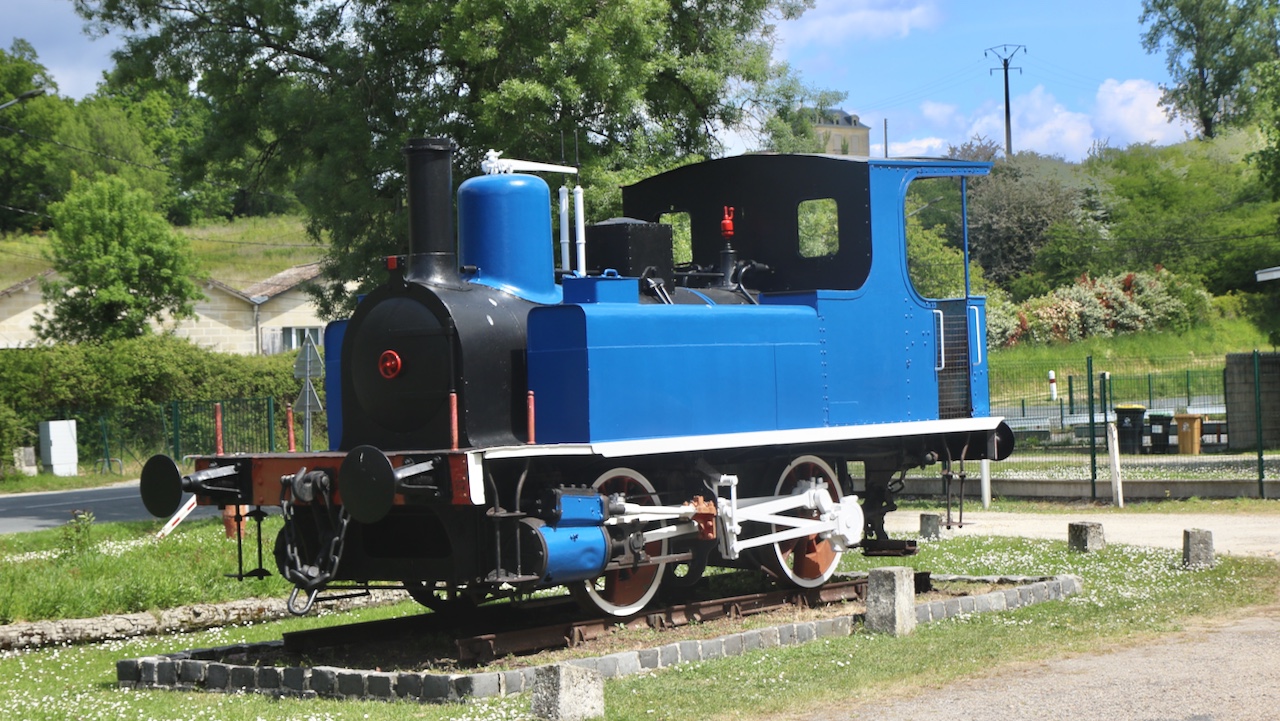June News 2024

On Saturday 20th April Train à Vapeur d'Auvergne organised a trip Le Thermal Express from Clermont-Ferrand to La Bourboule, recalling the first-class only named train from Paris which once served the thermal resorts of La Bourboule and Le Mont-Dore. With the overhaul of 141 R 420 still not complete, GADEFT supplied 140 C 27 seen above making a rousing start away from Volvic. Two single tracks run parallel here for several kilometres, that in the foreground being the line to Lapeyrouse which closed in 2007. More photos below. Photo: Erwan Quintin.
On 15th May the Gard Chambres des Notaries presented GADEFT with a cheque for €63,270 towards the future maintenance of 140 C 27. The department’s 200 notaries had donated €1 from every notarial deed signed during 2023 for a heritage restoration project. The money will enable an identified weakness in the axles of 140 C 27 to be repaired. In response, GADEFT invited the notaries to travel on a special charter from Nîmes to Marseille in October which will be hauled by 140 C 27.
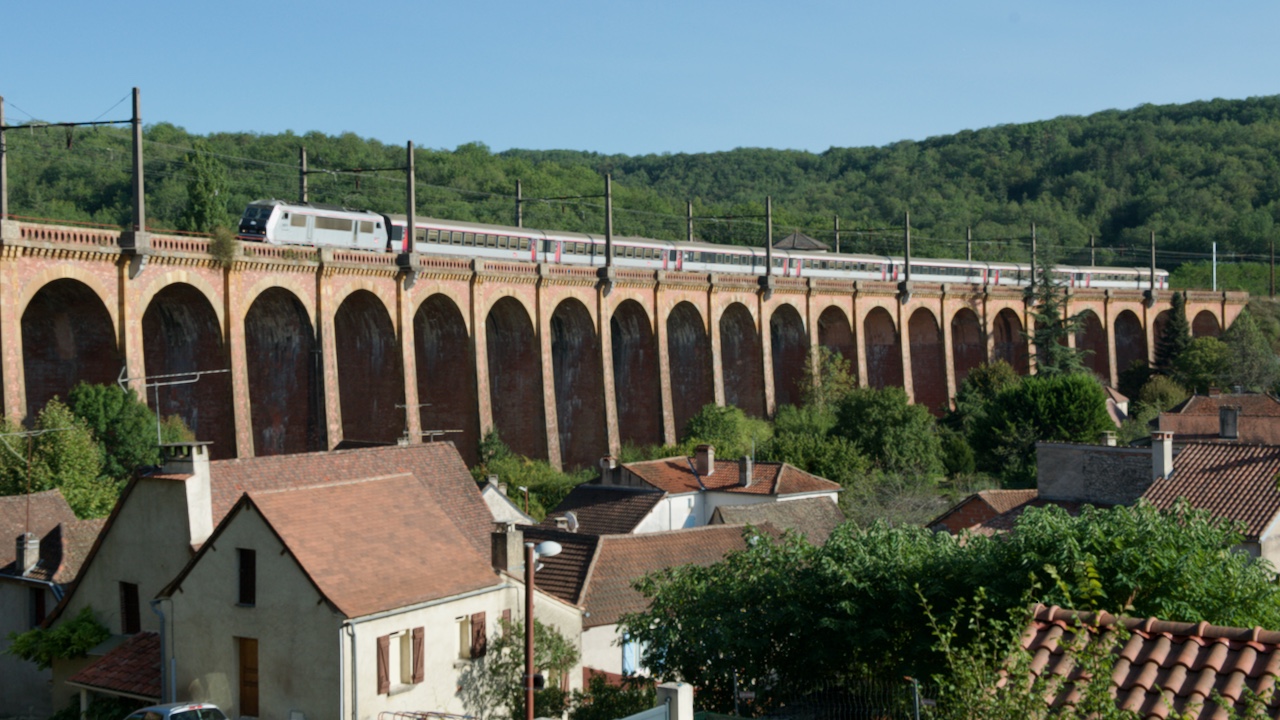
Above. The inhabitants of Calamane, north of Cahors, will have at least another three years of BB 7200 and BB 26000 rumbling across the village with Paris trains. BB 26015 heads north on the 6th September 2023 with Intercités 3694 16.32 Toulouse – Paris Austerlitz.
Oxygène delayed
At the end of April CAF announced that the Oxygène trains being built to replace locomotive-hauled Corail stock on Paris – Clermont-Ferrand and Paris – Orléans – Limoges – Toulouse (POLT) Intercités services will be delayed by a year and are unlikely to enter commercial service until 2027. Citing a range of reasons including Covid and the effect of the Ukraine war on supply chains, the main factor appears to be braking and traction motor problems that have arisen on the prototype during 25,000 km of testing at Velim since July of last year. CAF France’s CEO Alain Picard said that premature wear of the brake pads had been resolved, and had arisen from too intensive use in testing, which does not correspond to operation in commercial service. The traction motor issues, two of which presented excessive vibrations, were still being assessed by the manufacturer Melco, a Mitsubishi subsidiary. Once the problems have been fixed, the testing process will have to recommence from scratch.
In 2019 CAF was awarded a contract to build 28 ten-car 200km/h electric trainsets for the Paris – Clermont and POLT routes in preference to Alstom’s Coradia Liner, the long-distance version of the Régiolis, which could only offer a maximum of 160km/h. In 2023 a further 20 Oxygène units were ordered for Bordeaux – Marseille services. Each ten-car train will have 420 seats the equivalent of a seven coach Corail set. Two units will be able to operate in multiple providing the same capacity as the 14 coach Corail sets used on the busiest POLT duties. The interiors will provide a standard similar to the latest TGVs with 2+1 seating in first class.
Four trains are now nearing completion. CAF had originally planned to build the entire order at Bagnères-de-Bigorre and its Beasàin works in Spain, but since taking over the former Alstom Reichshoffen plant in eastern France only the first eight will be built at Beasàin with the remainder at Reichshoffen. Assuming rapid resolution of the traction motor problems, three more sets should begin testing from July. One will join the existing set at Velim for multiple working, with the other two for climate and maintenance testing. An unexpected element of testing so far has occurred with the test train hitting wild boar on a number of occasions on the 13.5km Velim circuit, that has proved the durability of the front nose.

Photo: © Radio France/Emmanuel Moreau.
Picard expects delivery of up to 14 of the trains by the end of 2026..Allowing for familiarisation and training, the units should enter commercial service in spring 2027, while the rest of the fleet should become available by the end of that year. The current plan now is for full commissioning and replacement of the Corail hauled stock by December 2028.
Summer Rendezvous - Sunday June 16th 2024
Ashtead Peace Memorial Hall
Woodfield Lane, Ashtead, Surrey KT21 2BE
(easy access M25/A3 and Ashtead station, Waterloo – Guildford/Dorking service)
Woodfield Lane, Ashtead, Surrey KT21 2BE
(easy access M25/A3 and Ashtead station, Waterloo – Guildford/Dorking service)
Open 10.00 am - 4.00 pm
Free Parking
Adults £6. Children £2 Family (2 +2) £10
Working layouts in various scales:
Free Parking
Adults £6. Children £2 Family (2 +2) £10
Working layouts in various scales:
Tenac - SNCF N - Tim Hills
Schinkendorf - DB HO - Simon Hargraves
San Dimitrio - FS HO - Andy Housden
Saint Pankraz - OBB HO - Mike Upton
Leissigbad - Swiss N - Gordon Wiseman
Fideac - SNCF N - Paul Jobber
Heigen Hof - DB O - Roy Sparrow
Saint Martin Le Gaillard - SNCF HO - Stuart Robinson
Santa Agueda - Portuguese HO - Martin Petch
Verneil - SNCF N - Jon Cassidy
O Gauge Test Track - Andy Housden
Specialist Trade Stands
Bring & Buy
Refreshments
European Society Groups
Digital Photo Presentations
Schinkendorf - DB HO - Simon Hargraves
San Dimitrio - FS HO - Andy Housden
Saint Pankraz - OBB HO - Mike Upton
Leissigbad - Swiss N - Gordon Wiseman
Fideac - SNCF N - Paul Jobber
Heigen Hof - DB O - Roy Sparrow
Saint Martin Le Gaillard - SNCF HO - Stuart Robinson
Santa Agueda - Portuguese HO - Martin Petch
Verneil - SNCF N - Jon Cassidy
O Gauge Test Track - Andy Housden
Specialist Trade Stands
Bring & Buy
Refreshments
European Society Groups
Digital Photo Presentations
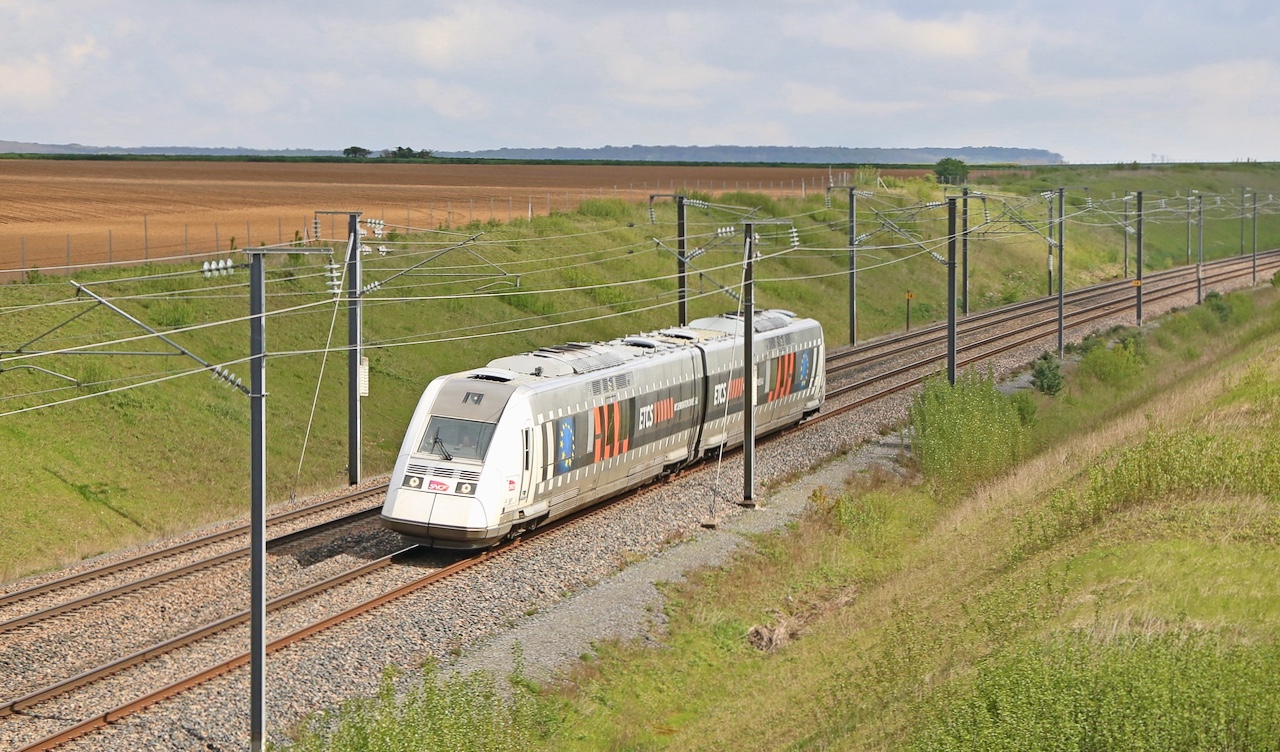
On the 18th and 24th April, the ERTMS control railcar X 72633/634 carried out night-time tests on the Coubert triangle southeast of Paris where LGV Sud-Est meets the Interconnexion line heading north. The tests are part of the LGV+ ERTMS (European Rail Traffic Management System) deployment on the Paris – Lyon LGV where 58 new interlockings and a new control centre are being installed to replace the originals now 37-years-old. These will be brought into operation over the weekend of 9/12th November during a total closure of the route. The railcar was modified in 2018 at Nevers Technicentre and equipped with the TVM 430 track-train communications system for working on high-speed lines. Based at Longueau, it is seen above at Charny on the LGV Est having reversed at Chauconin en route to Marne-la-Vallée-Chessy.
Photo: Christophe Masse.
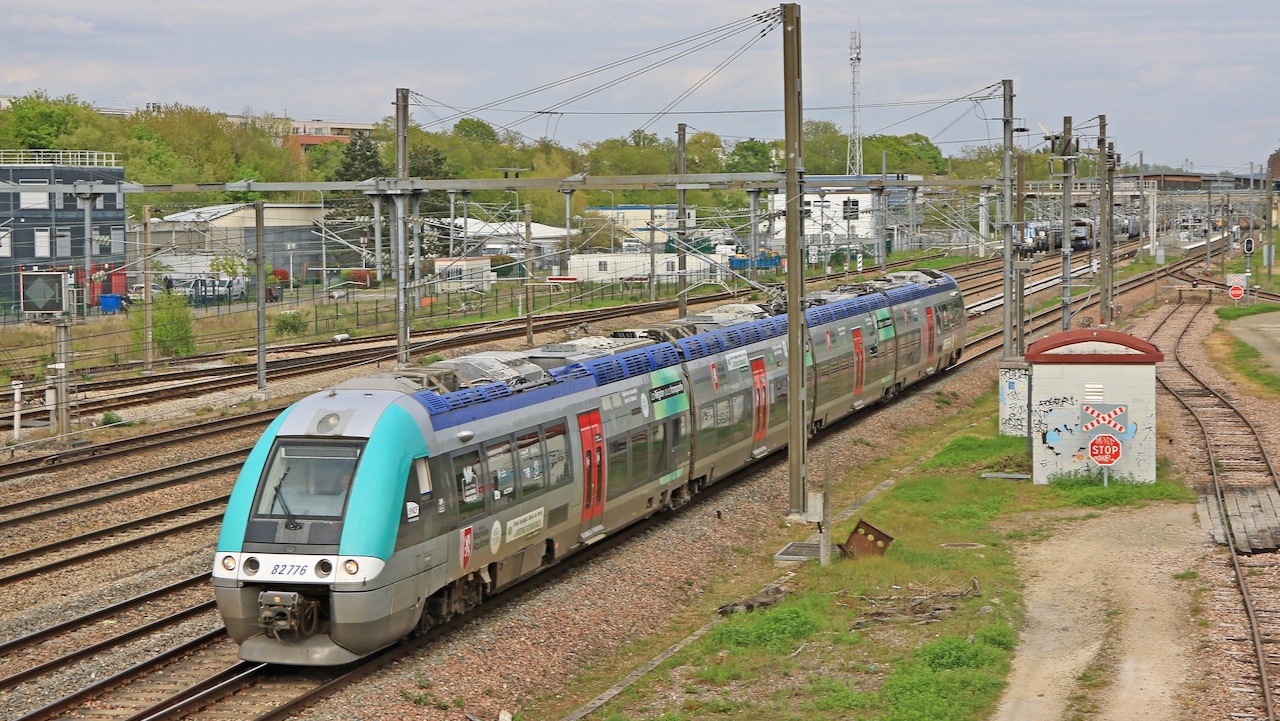
Decorated with the emblems of the regions supporting the project, on 27th April the prototype battery-powered AGC B 82775/6, known affectionately as the 'Batmobile', pulls away from Vaires-Torcy station having stopped to pick up a pilot whilst en route to Les Aubrais via Valenton. It was scheduled to undertake testing between Les Aubrais and Vierzon. Photo:Christophe Masse.
Another prototype currently on trial is the diesel-battery hybrid Régiolis MU B 83519/20. Having run over 8,000km in passenger service on lines out of Toulouse (see May 2023 News), the train moved to Bordeaux on 6th April for a further four months’ public trials in Nouvelle-Aquitaine, initially between Bordeaux and La Rochelle. Early results in Occitanie are considered satisfactory, with running on bio-fuel cutting CO2 emissions by 90% and particles by 23%, for a 20% reduction in fuel consumption. Regenerative braking achieved up to 90% recovery. Nouvelle-Aquitaine aims to eliminate use of diesel fuel by 2030.
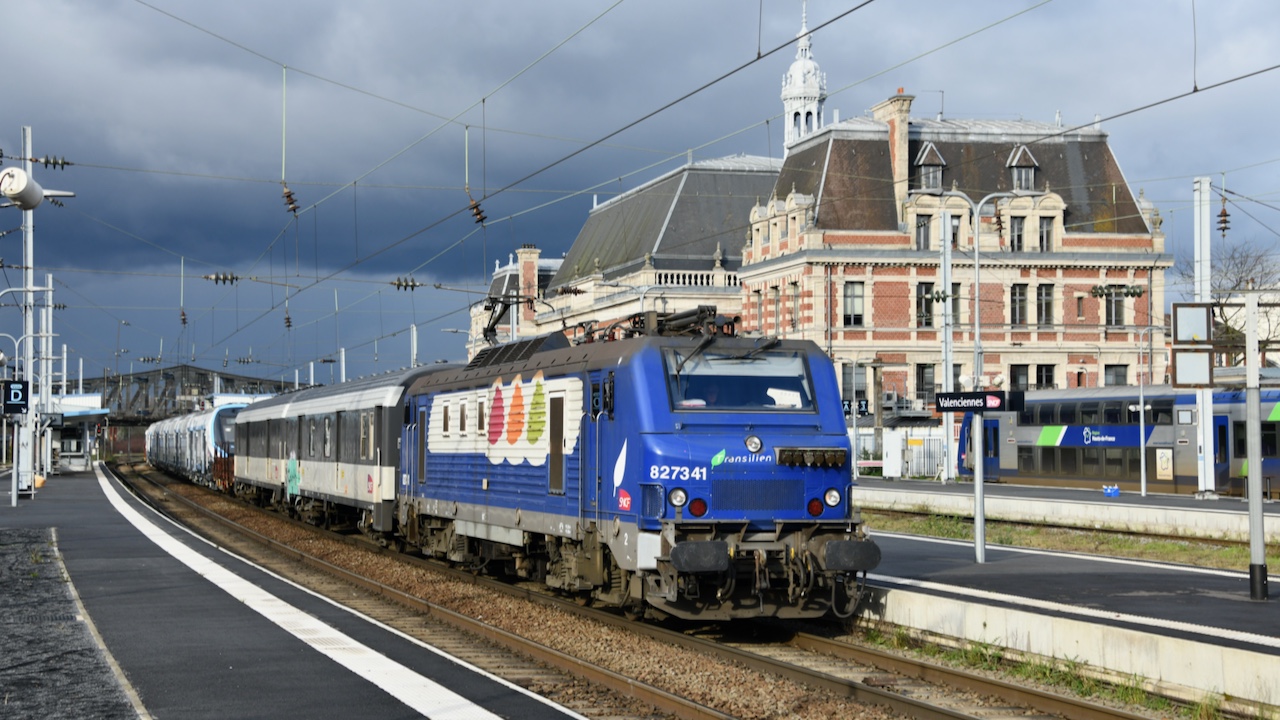
With work for BB 27300s from Paris Saint Lazare continuing to decline, BB 27341 has been transferred out of the ÎdeF Ligne L/J pool and assigned to the AEF pool (l’Agence d’Essai Ferroviaire) for transferring new rolling stock. On the 5th March BB 27341, still in its ÎdeF 'Teardrop' livery, is seen heading through Valenciennes towing RER NG 026K en route to CEF2 (Centre d'Essais Ferroviaires) at Tronville, near Bar-le-Duc. Photo: Didier Delattre.
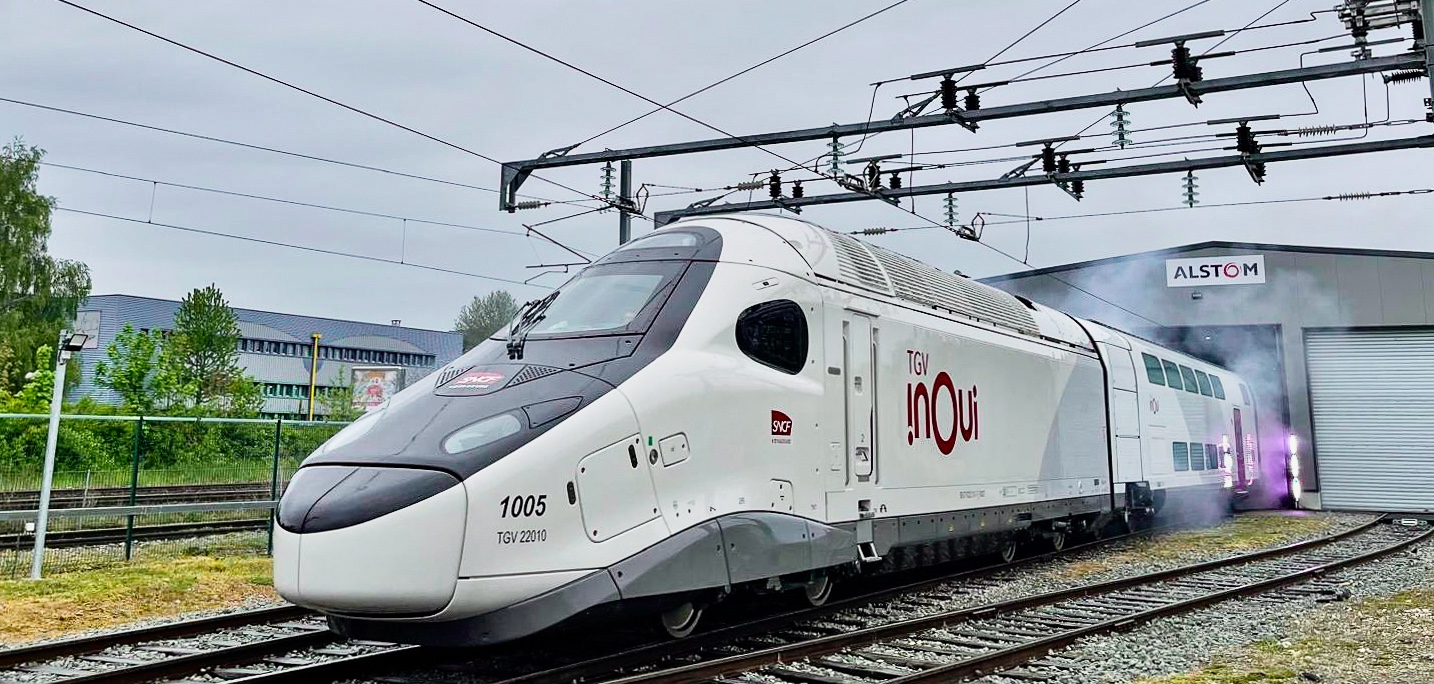
Alstom and SNCF Voyageurs unveiled the livery for the TGV M production series on the 29th April when set 1005 was rolled out at Belfort. The white and light grey livery is described as timeless and sober, reflecting the identity of the TGV Inoui brand with the clear palette expressing the comfort and softness of the TGV Inoui experience. The so-called 'Frenchberry' red is concentrated on the doors, as an invitation to enter and discover the interior spaces. Photo: SNCF Voyageurs.
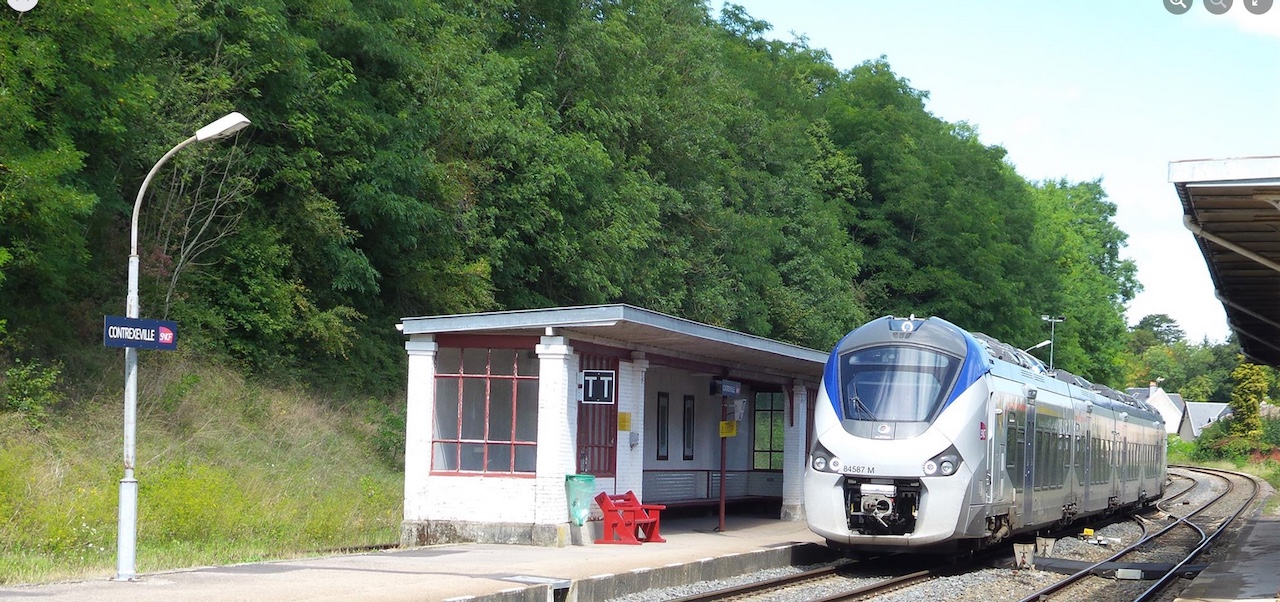
Contrexéville first for Grand Est
In a ‘historic and symbolic’ act, Grand Est région announced on 24th May that a consortium of Transdev, NGE Concessions and Caisse des dépôts has been awarded a concession to restore, manage and operate the Nancy – Contrexéville line, closed in 2016. This is the first rural line to be taken over by Grand Est (see April News), using funding from a €300 million investment under the région’s Pacte pour les Ruralités. Rehabilitation should begin in the autumn for opening in December 2027.
The 22-year concession is complicated by several factors, including the varying condition of the infrastructure, SNCF’s retention of the 5km from Vittel to Contrexéville as part of the national network to carry mineral water traffic, and the residual passenger service operated from Nancy to Pont-Saint-Vincent. SNCF has established new boundary points between its own territory and the concession. The line has been divided into three sections: (Nancy) Jarville-la-Malgrange to Pont-Saint-Vincent (13km); Pont-Saint-Vincent – Xeuilly (4km); and Xeuilly – Vittel (60.5km).
Transdev will take over the existing Pont-Saint-Vincent passenger service, currently 19 A/R daily, and will have access rights into Nancy gare and from Vittel to Contrexéville to run the restored service between Nancy and Contrexéville. Transdev will undertake modernisation and upgrading of the closed section between Pont-Saint-Vincent and Vittel (64.5km). Double track will be retained as far as Xeuilly, the remainder singled with a passing loop at Mirecourt. Thereafter, Transdev will be responsible for infrastructure management and maintenance of the entire route between Jarville and Vittel (75km).
As well as upgrading for 120km/h running, the route will be resignalled to accommodate the restored service, and a rolling stock and infrastructure maintenance depot built at Mirecourt. Total cost of the work is €150 million, whilst annual operating costs are put at €14 million. Trains will serve reopened stations at Messein, Ceintry, Vézelise, Mirecourt, Vittel and Contrexéville, plus halts at Diarville and Praye-sous-Vaudemont. There will be hourly service on weekdays and about every two hours at weekends, with some trains turning short at Mirecourt. Rolling stock will be supplied by Grand Est from its own fleet.
Grand Est had announced in April that the Draisy experimental lightweight railcar would be trialled on the Sarreguemines – Bitche line to test its suitability for incorporation in the région’s reopening plans.
Régiolis B 84587/8 on a Nancy train at Contrexéville in the summer before closure in December 2016. The good state of the track here reflects its use by trains carrying mineral water from the sources at Vittel and Contrexéville southwards to the depot at Merrey for onward haulage to Arles and Montreuil-Bellay. Photo: Association Gare de Contrexéville.
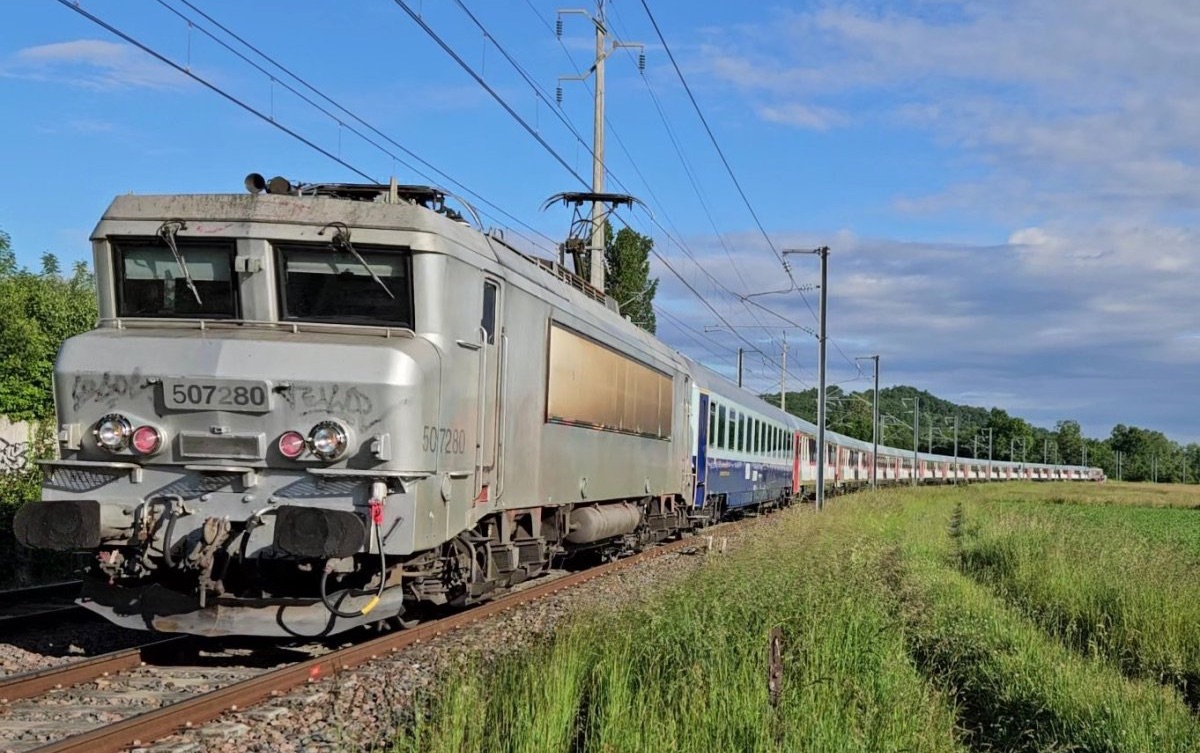
Few trains these days need banking up Capvern incline east of Tarbes, the 8km at 1 in 33 being one of the most severe main line gradients in France. Exceptions are military specials and returning pilgrim trains from Lourdes, one of which is seen on 21st May at PN143 on the climb from Tournay. Barely half-an-hour into its two-day journey, Train 29956/57 the 08.13 Lourdes – Vintimille – (Syracuse) paused at Tournay where BB 7200 7250 came on to the rear to assist train-loco No 7280 up the bank to Capvern summit (597m). Due in Vintimille at 19.58, the 14-coach train then continued its journey the length of Italy and across the Strait of Messina by train-ferry to Syracuse in Sicily.
Photo: Chris Bushell.
The first car on the train, Pellegrinaggio nazionale dei Piccoli a Lourdes (National pilgrimage of the Little Ones to Lourdes), was a sleeper car of Treni Touristici Italiani (61 83 50-70 339-2 I-TI). It was the first time this car has visited Lourdes. Photo: Georges Turpin.
With the pilgrimage in full swing over the Whitsun weekend, trains from Germany running via Basle arrived at Lourdes on the 18th and 23rd May, returning on the 23rd and 27th. That on the 23rd, Train 27893 hauled from Toulouse 1h 30 late by BB 7280, comprised nine Corail coaches; hauled SNCF stock is an unusual sight at Lourdes these days.
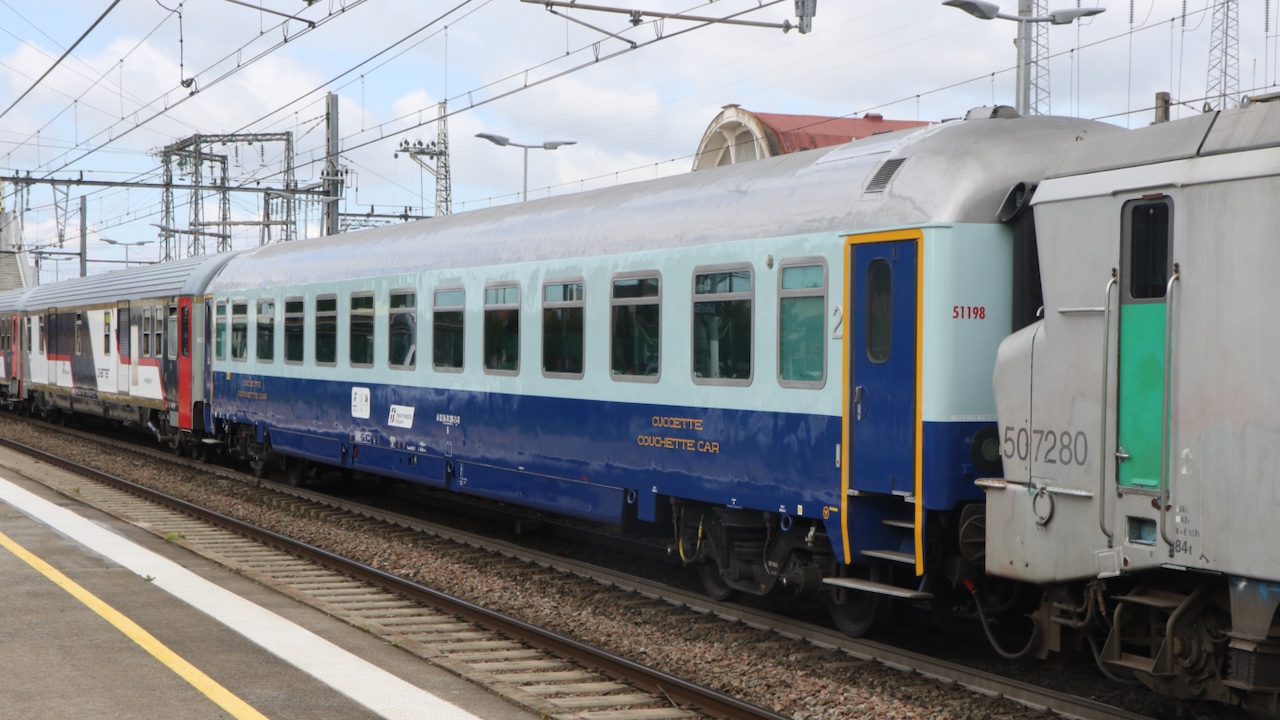
Sunday the 19th brought TGVs from Genève (arriving 17.24) and Annemasse (17.42). These reached Lourdes from the west having travelled round Paris to avoid engineering works at Toulouse Matabiau.
The weekend of 8/12th May saw no trains operating from Toulouse on routes to Bordeaux, Limoges, Bayonne, Latour-de-Carol and Narbonne. Trains on the Auch line terminated at Saint-Cyprien-Arènes, with only Rodez and Mazamet services operating from Matabiau station. Below, at the south end of the station several sections of track were renewed, while towards Saint-Jory preparatory work was being undertaken for the LGV GPSO. Photo: Georges Turpin.
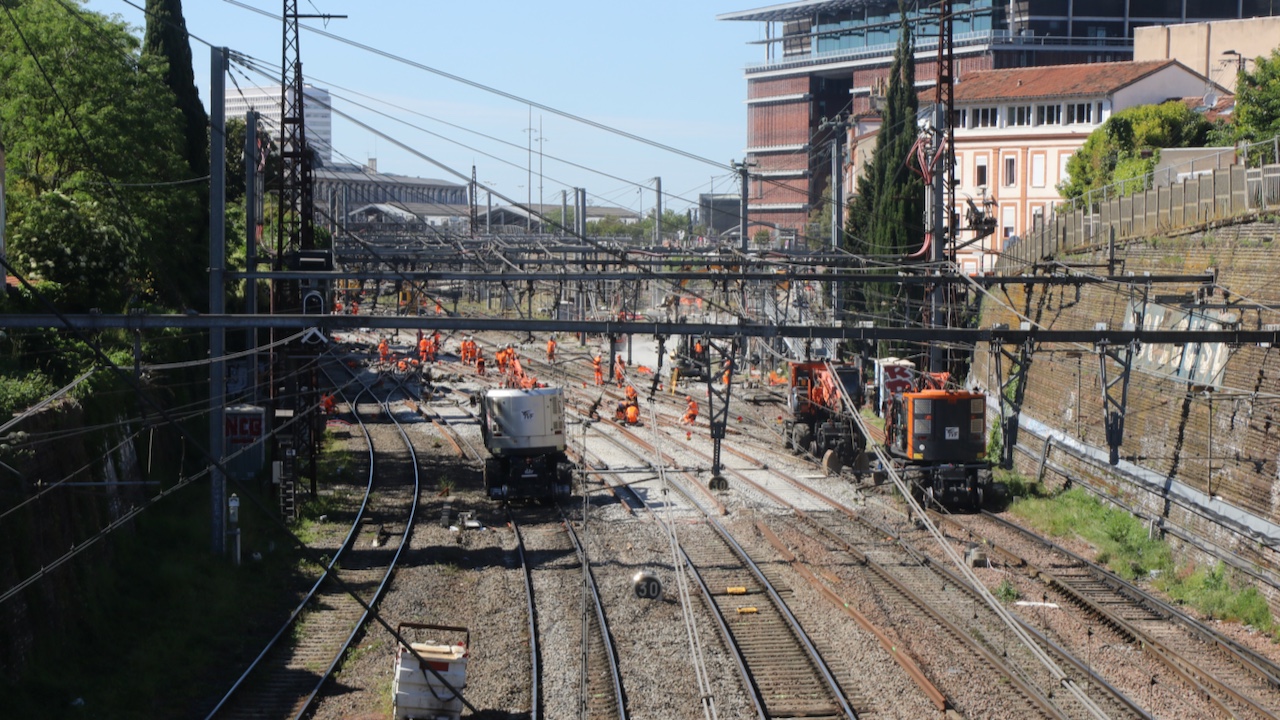
News in brief
Eurostar. Is seeking tenders for 50 new trains. Following the merger with Thalys it now has a combined fleet of 51 sets made up of four different types; 17 PBKA and nine PBA TGVs, eight Class 373s and 17 Siemens e320s. The e320s will be retained and with the new trains will give Eurostar a fleet of 67 trainsets with interoperability across the five countries it operates between. It will also provide the capacity to increase passenger numbers from 18 million in 2023 to 30 million by 2030. A firm order is expected in 2025 with the new trains entering service in the early 2030s
From 4th November, the travel classes on all services will be renamed Eurostar Standard, Eurostar Plus and Eurostar Premier. New booking flexibility allows passengers travelling in Standard and Plus to change their ticket without any fee up to 1h before departure, while from November Premier passengers will be able to change their ticket or get a refund with no fee up to two days after departure date.
ID required. A spate of online grumbles by passengers fined for not being able to present ID at onboard ticket inspections led SNCF to reiterate that an identity card, passport, driving licence or residence permit must be carried in addition to the travel ticket and discount card (if applicable); only physical documents are acceptable, photocopies or downloads are not valid. Travellers from Britain should remember to have their passports with them always as they can be asked to produce ID at any time and in any circumstances.

Calais. A year in to the upgrade of La voie mére de Calais, the Calais port railway (see August 2023 News), new track and a noise barrier have been completed alongside rue Mollien to improve conditions for residents. Phase 2 will see the line diverted to avoid several other residential areas. €83 million is being spent to raise capacity from three or four daily trains to 15 A/R by 2040. Photo: La Voix de Nord/Sébastien Jarry.
Bordeaux. Public consultation starts on 2nd September for proposals to spend up to €100 million on a facelift and improved access to Gare Saint-Jean, where passenger throughput is expected to increase 50% by 2030 to 30 million annually. Parking and drop-off facilities will be improved, more cycle space added, the forecourt made car-free, and public areas replanned and landscaped .
Bordeaux – Saintes. Renewal of 40km of life-expired track at a cost of €70 million was announced at a meeting on 24th April between Nouvelle-Aquitaine president Alain Rousset and SNCF Réseau’s Matthieu Chabanel. The lengthy pway slack of between 40 and 60km/h is responsible for a 20min time-penalty over the 123km between Bordeaux and Saintes, where some 5,300 journeys are made daily. Work will start next year.
Talence. Work started on 10th April to reopen Talence-Médoquine station, 4km west of Bordeaux-Saint-Jean. Located at the junction of the Hendaye/Arcachon line and the branch to Le Verdon, the station will be a multimodal interchange (PEM) designed to reduce the number of passengers needing to change at Saint-Jean as the SERM network develops. The original building, out of use for 75 years, will be refurbished and four platforms built; total cost is €25.5 million. Opening in September 2025, this is the second new station in the area after Le Bouscat Sainte-Germaine on the line to Le Verdon, opened last June. Around 1.5 million passengers a year are expected to be using Talence station by 2030.
Colmar. Over 800 people joined hands across the Rhine bridge between Vogelgrun and Breisach on 14th April to draw attention to the lack of passenger service between Colmar and Freiburg in Germany. The rail bridge here was completely destroyed in WW2 and never rebuilt. Local officials in both countries support reopening; they hope that agreement can be reached on sharing the substantial cost for reopening by 2030.
Systra. At the end of April, SNCF and RATP entered into ‘exclusive negotiations’ for sale of a majority shareholding in Systra, the international engineering and consultancy group of which each owns 43.4%. Latour Capital and Fimalac intend to acquire of 58% of Systra's capital, while SNCF and RATP will retain 20% each.
Nîmes. An unusual record is held by Nîmes-Centre gare which SNCF says has the country’s highest non-passenger footfall outside Paris, with 2.7 million ‘visitors’ in 2022 who did not take the train. Mostly, they walk through the station between the old and new areas of the city, often stopping to meet, shop and eat.
Bad-mood music. Negotiations between SNCF and the Profedim union reached an impasse over accommodation of large instruments such as harps and double-basses on TGVs after complaints of musicians being fined or refused access to trains on safety grounds. The option of storage in a dedicated space in the buffet was rejected as musicians wish to keep their instruments within sight.
Primeurs. Transport minister Patrice Vergriete has confirmed that a new operator will be sought to relaunch the Perpignan – Rungis Train des Primeurs after its withdrawal during 12 months’ rebuilding work at Rungis in 2025.
TELLi lab. X 73525, the DMU car bought by Nouvelle-Aquitaine région as part of the TELLi innovative lightweight train project, has been equipped with sensors, computers, cameras and LIDAR. Currently operating in public service on routes out of Limoges, the car is collecting data for optimisation of preventive track maintenance and other parameters to define new standards for rural railway infrastructure.
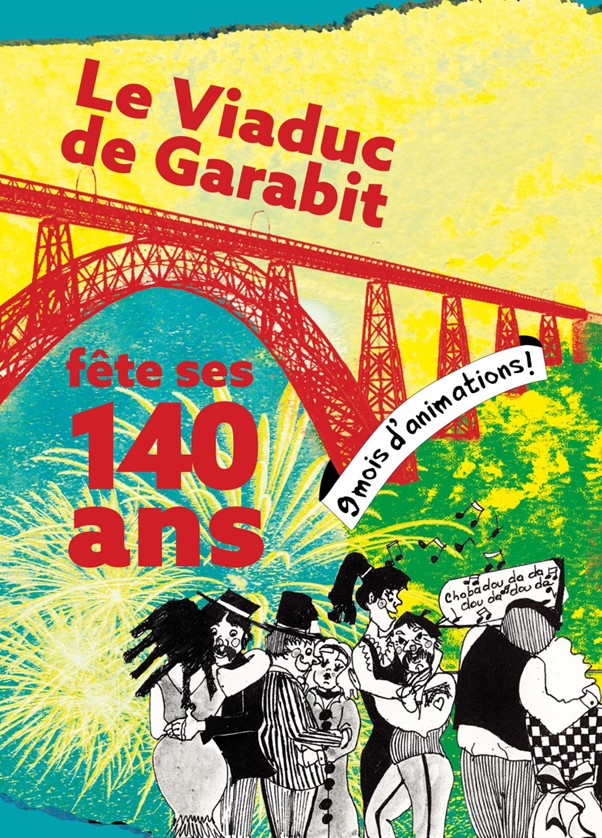
Garabit. April saw the start of nine months of events and activities at Saint-Flour and the surrounding area to celebrate the 140th anniversary of Eiffel’s viaduc de Garabit, culminating in a day of events, workshops and visits, a concert and evening fireworks spectacular on 21st September. The programme can be downloaded from this link Photo: Agence Saint-Flour.
Niort – Saintes. The line is closed for upgrading from 21st May until November, and will be again during 2025. A total of 77km of track is being renewed to eliminate the long stretches limited to 60km/h between Saintes and Saint-Jean-d’Angély.
Quillan pledge. Occitanie is ‘totally committed’ to reopening between Limoux and Quillan (28km) the région’s transport head Jean-Luc Gibelin has assured pressure groups. Delays to the original timescale have been exacerbated by the State’s designation of the project as an opening rather than a reopening, so that two years of environmental studies have been required instead of 12 months. He confirmed 2030 as the likely start of service.
Albret. The Nérac – Mézin tourist train will not run this season following an impasse between the operator and Albret communauté des communes over access at Nérac station where some track has been removed to facilitate introduction of a voie verte. Albret’s call for tenders to run the railway produced no bids, not even from the current operator. Now Lot-et-Garonne préfecture has ordered the line’s closure pending appointment of a new operator.
Retirement deal. Trades unions have agreed end-of-career pay and working conditions offered by SNCF in the hope of avoiding strikes during the Olympic Games as well as easing staff relations generally. CEO Jean-Pierre Farandou said in February that he aimed to end ‘the threat of strikes as the entry point for dialogue between unions and SNCF’. The early-retirement package includes an 18-month ‘winding-down’ period in which staff would work 50% of the time for 75% of the pay, with those in more arduous jobs or working unsocial hours paid 100% for 15 months’ work then 75% for 15 months’ pre-retirement leave.
No extension for Farandou. The agreement (above) caused controversy as it appears counter to the spirit of the national pension reforms enacted last year; as a result the CEO was called to explain the terms to the Senate finance committee on 7th May. Shortly after, the government announced that the expected two-year extension of Farandou’s mandate, until retirement at 68, would not be offered. Instead, he will leave post after guiding SNCF through the Olympic Games period. Government sources insisted that this was on account of his age and unconnected to the staff retirement deal.
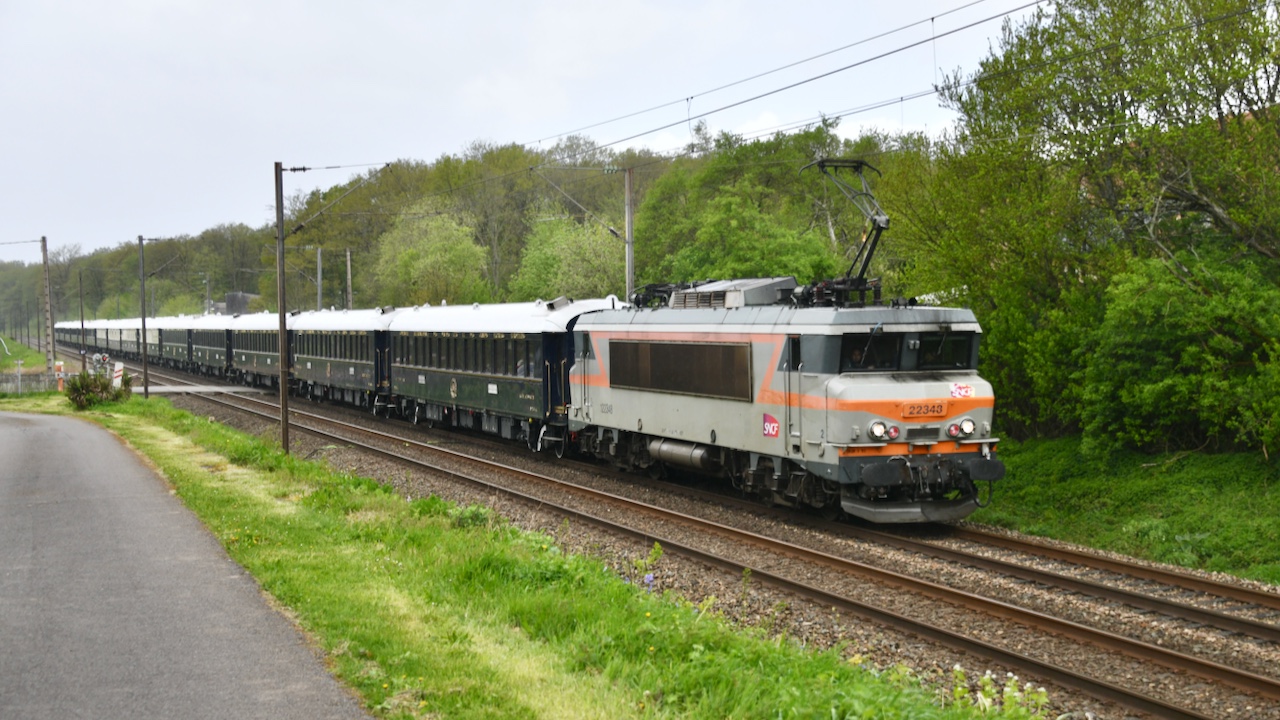
The VSOE no longer regularly works to Calais, but now operates mainly from Paris and between major european cities. On 16th April BB 22348 is seen approaching Aulnoye-Aymeries with VSOE 13001 Venice – Amsterdam that it had worked from Paris Est. At Aulnoye it was replaced by SNCB 1866 Photo: Didier Delattre.
SERM designation. On 23rd April the transport ministry set out the methodology that will allow communities to obtain the designation SERM for their metropolitan rail proposals. A first tranche will be announced this summer, based on brief project summaries drawn up by promoters. This will be followed at the end of the year by official designation after consideration of more-detailed synthèses du project. These will set out objectives, development timetable, financing plans and governance structure for each of the planned schemes in 30 communities. set out below:
Angers, Avignon, Basco-Landais, Béarn-Bigorre, Belfort-Montbéliard, Besançon, Bordeaux, Brest, Caen, Clermont-Ferrand, Dijon, Grenoble-Chambéry, La Rochelle, Léman Express-Annemasse-Genève, Le Mans, Lille, Lyon-Saint-Etienne, Lorraine-Luxembourg, Marseille-Toulon, Montpellier, Mulhouse-Bâle, Nantes, Nice, Orléans, Reims, Rennes, Rouen, Strasbourg, Sud-Morbihan, Toulouse, Tours.
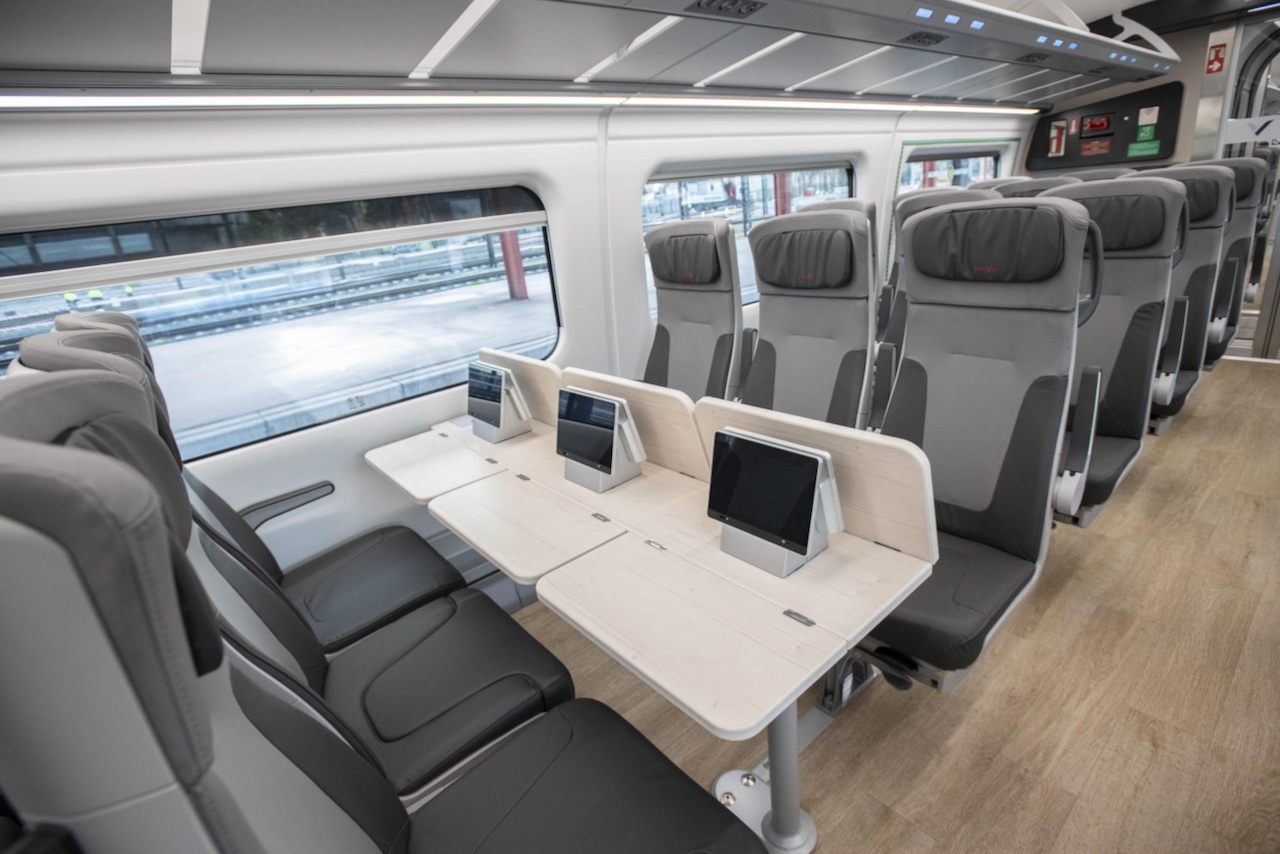
RENFE AVE. New-generation S-106 trains entered service in Spain on 21st May, the fleet of 30 being promoted as ‘Europe’s most modern’. The three classes, Comfort, Standard and Tourist, all have at-seat tactile video screens. They will operate RENFE’s Paris – Lyon – Marseille and Paris – Barcelona services as soon as clearance is received for running in France. Photo: RENFE.
Aubrac. With the northern section closed until 1st November for relaying, SNCF Réseau announced at short notice further work that sees the entire line shut until 28th June. €6.9 million is being spent on track upgrading, drainage improvements and stabilisation of rock cuttings at several locations between Béziers and Saint-Chély.
Auxois. A consultants’ report into the feasibility of restarting tourist trains between Venaray-Les Laumes-Alésia and Semur-en-Auxois (20km) was published on 22th April. Chemin de fer touristique de l’Auxois operated a service until the route was severed by a freight train derailment in 2013. Côte-d’Or département will decide in the autumn whether to proceed with the project, which is costed at €2.8 million.
Paray-le-Monial. Local officials and users’ groups met here on 4th May to protest at decline of the (Tours) – Nevers – Lyon service run by AURA, for which Bourgogne-Franche-Comté region is planning to withdraw its contribution. Poor track between Paray and Gilly-sur-Loire delays the trains, as does closure of the passing loop at Lamure-sur-Azergues. Saône-et-Loire département will pressure BFC to rethink its lack of commitment.
Paray-le-Monial. Local officials and users’ groups met here on 4th May to protest at decline of the (Tours) – Nevers – Lyon service run by AURA, for which Bourgogne-Franche-Comté region is planning to withdraw its contribution. Poor track between Paray and Gilly-sur-Loire delays the trains, as does closure of the passing loop at Lamure-sur-Azergues. Saône-et-Loire département will pressure BFC to rethink its lack of commitment.
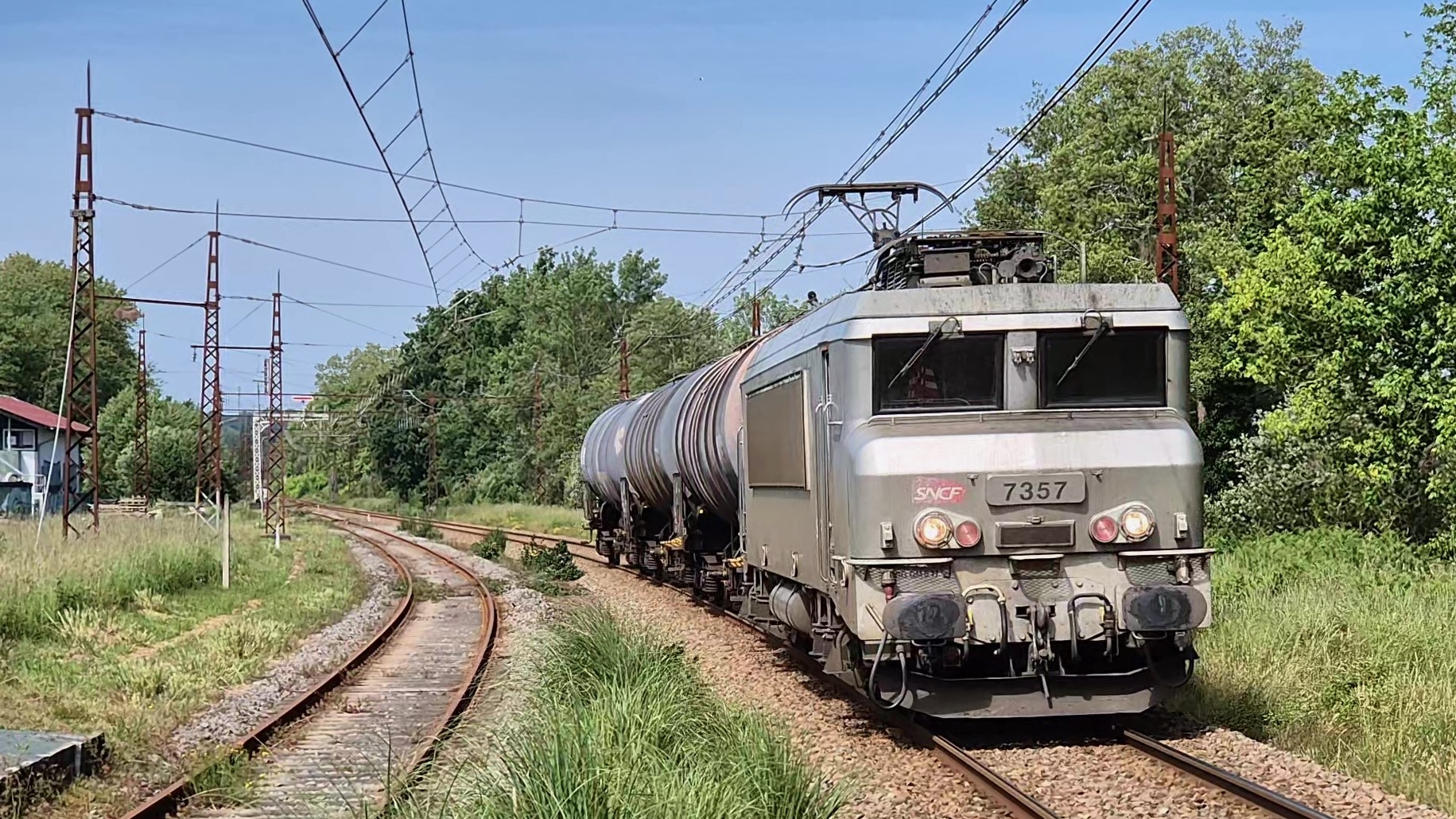
At Urt on 13th May, BB 7200 No 7357 rushes through at 10.49 with three VTG tankers on 489292 Bayonne – Artix, one of only a handful of trains running in the area on this local strike day. The 32km single line between Bayonne and Puyoô, at the base of the triangle formed by the lines from Dax to Hendaye and Tarbes, carries five TERs and four Toulouse – Bayonne ICs each way daily, the Tarbes night train, as well as trip freight workings to and from Bayonne and Puyoô or Artix, where traffic from the Lacq industrial complex is handled.
Still manually signalled, the line suffers from poor reliability as only two passing loops remain, at Urt and Peyrehorade; congestion on the single line sometimes necessitates diverting traffic via Dax where trains must reverse. A new telecommunications system was to have been installed this spring but work has been postponed until 2027. Last year the line saw €5.5 million spent on redecking the Ardanavy river bridge at nearby Urcuit. Photo: John Bamforth.
Railcoop – end of the dream
In the Cahors Commercial Court on 29th April Railcoop was finally put into liquidation, ending the dream of a rail operator owned as a co-operative by its members. It had been placed into judicial administration on 16th October with a deficit of €4.7 million and given six months to raise sufficient capital to pay its debts and launch its proposed Bordeaux – Limoges – Lyon service. A solution was developed based upon the co-operative operating the service with a separate company owning the rolling stock and assets. Although this did not appeal to many of the co-operative members, it was a pragmatic solution to keep Railcoop alive. Spanish infrastructure investor Serena Partners was prepared to put up 60% of the capital required. Railcoop planned to bridge the gap by selling its two X 72500 railcars to Romanian operator Marub SA, although it is unclear how they could have then operated a service. This ran into trouble when ACC M at Clermont-Ferrand, which had been undertaking refurbishment work, refused to release them until an outstanding €160,000 had been paid. ACC M subsequently obtained a court judgement for this amount.
With over 14,000 individual, civic and corporate members, hundreds of small investors have lost their money following Railcoop’s failure. Typically this was €300-400 for individuals. Amongst the larger supporters of the co-operative were Lyon métropole which invested €100,000, Grand Est région (€300,000), and the city of Toul (€8,000). The latter two would have been served by the proposed Lyon/Grenoble – Dijon – Thionville route, one of the many that Railcoop proposed to introduce following establishment of the Bordeaux – Lyon service.
Matabiau Marengo
As well as the new seven-storey SNCF regional headquarters at one end, the building will cover 4,200m2 on several levels linking SNCF services with metro, buses and parking for 1,000 cycles, plus retail and event space. The predominantly rose-coloured materials echo the pink brick of La ville rose.
Construction of the €65 million building is expected to start in 2026 for opening at the same time as metro Line C in 2028.
Architect’s impression: Bjarke Ingels Group.
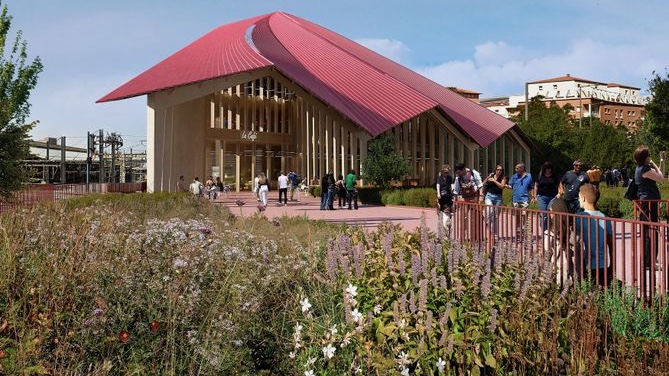

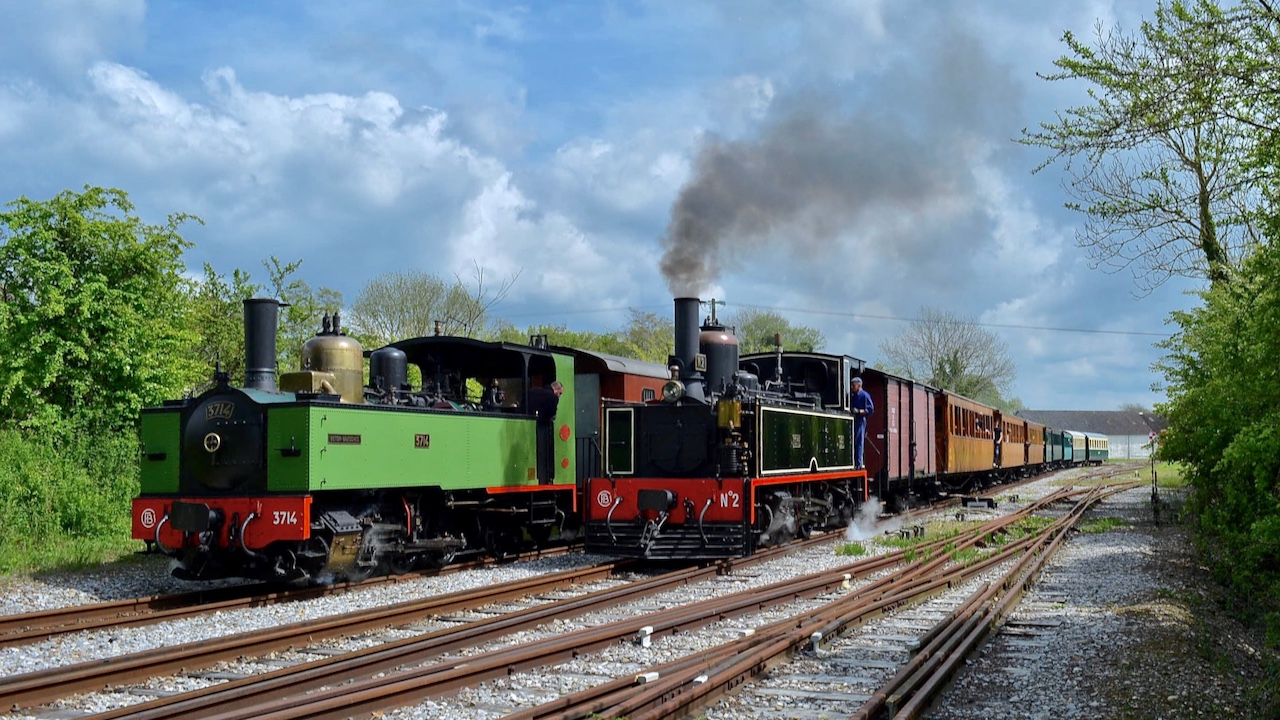
On the 1st May the CFBS Buffaud Robatel 0-3-1T 3714 and Cail 1-3-0T No.2 head out of Noyelles with afternoon services to Le Crotoy and St Valery. The CFBS enjoyed a hectic Ascension bank holiday weekend carrying over 10,000 passengers on the four days from Thursday 9th May.
A new daily record was set on the Friday with 3,392 passengers carried, in the evening all available rolling stock saw service with supplémentaires needed to transport the returning crowds. Photo: Philippe Armand.
CFBS unveils Saint-Valery Canal development
CFBS has unveiled its plans for future development at Saint Valery Canal depot. Planning permission has been sought to erect a 150m-long canopy covering four tracks with an adjoining reception building (see below). Image: Jean-Pierre Bouchet.
The structure will allow all rolling stock to be kept under cover when not is use, reducing environmental impact on the coach bodies, and provide a visitor viewing area for some of the historical rolling stock. There remains a long administrative and financial road ahead, but it is hoped that the project can be completed by 2030. Right, the current view of the proposed site looking from the opposite direction.
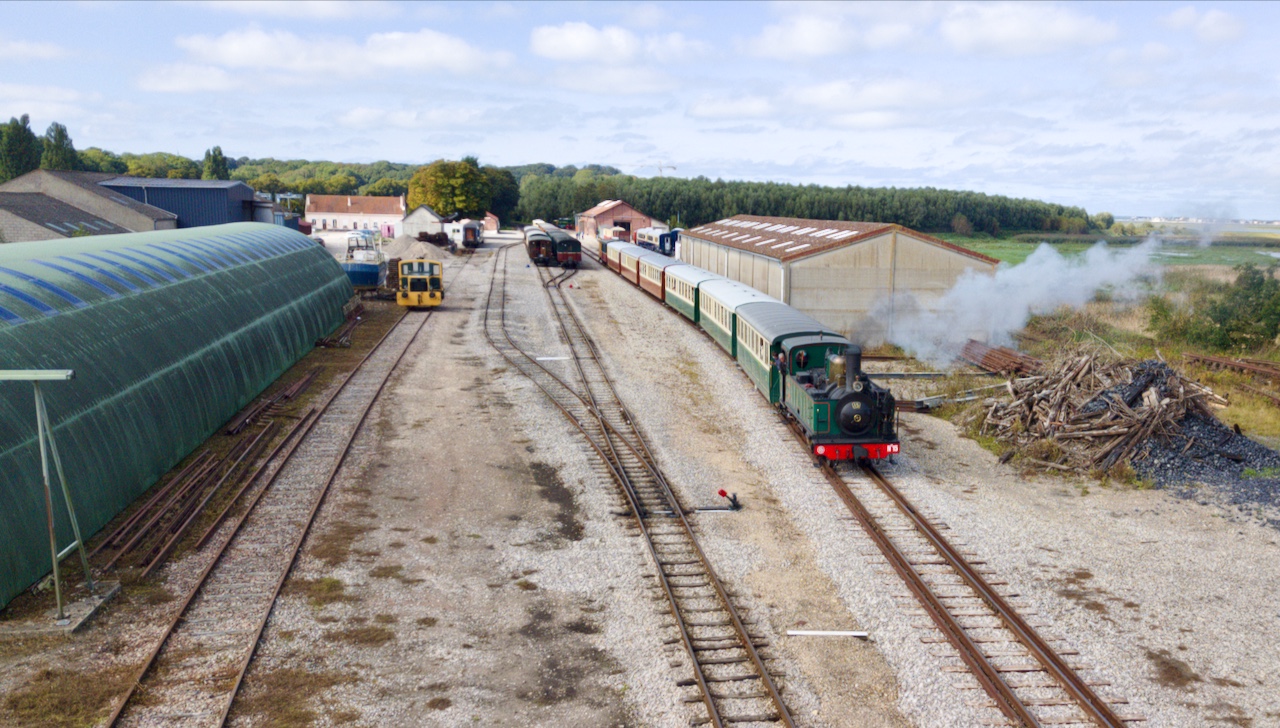
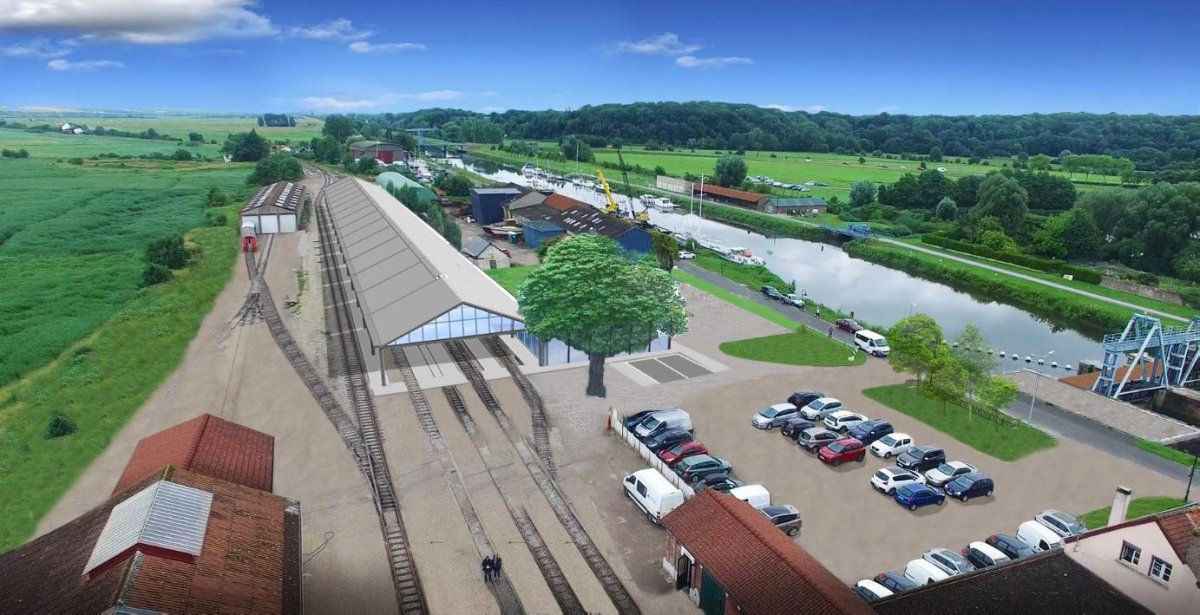
241 P 9 Update
Restoration of 241 P 9 continues at Toulouse. It remains in the former Matabiau depot opposite the turntable at the Narbonne end, along with a tool van and a postal carriage. They must now vacate the site by the end of June, rather than September, as the depot is scheduled for demolition as part of the Grand Matabiau redevelopment and work in connection with metro Line C and the Bordeaux – Toulouse LGV.
Work on the bogie has been completed over the winter and all wheels are now attached to the locomotive, along with brakes and suspension. Recent work has focussed on fitting the motion, cab and boiler casing and other items before the move. Retubing the boiler will be completed after the move. The former mining town of Carmaux has agreed to host the locomotive, seeing a connection with its industrial past as 241 P 9 was a coal burner.
The proposal is to take over three tracks in the former goods yard, unused for some years, and build accommodation for the locomotive and equipment. This would include new track and points suitable for the locomotive’s long wheelbase. It is also planned to dismantle the 24m turntable at Matabiau for reassembly at Carmaux. The whole area would also need to be fenced off and secured.
Whilst the new site is being prepared, 241 P 9 will be housed in a temporary structure opposite the station BV, estimated to cost €30,000. Photos: Georges Turpin.
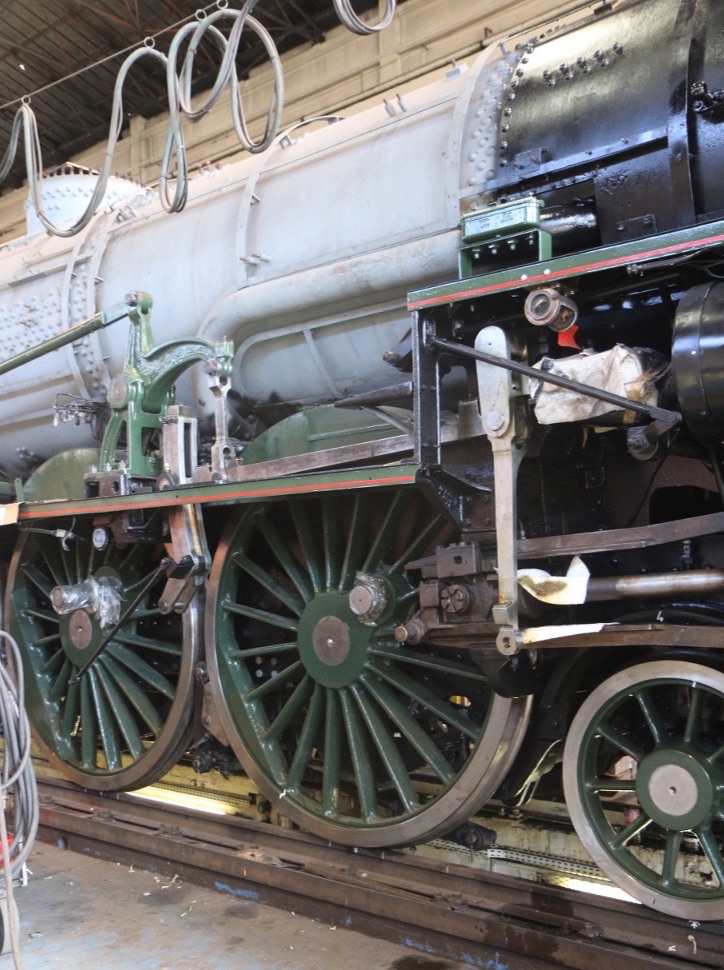
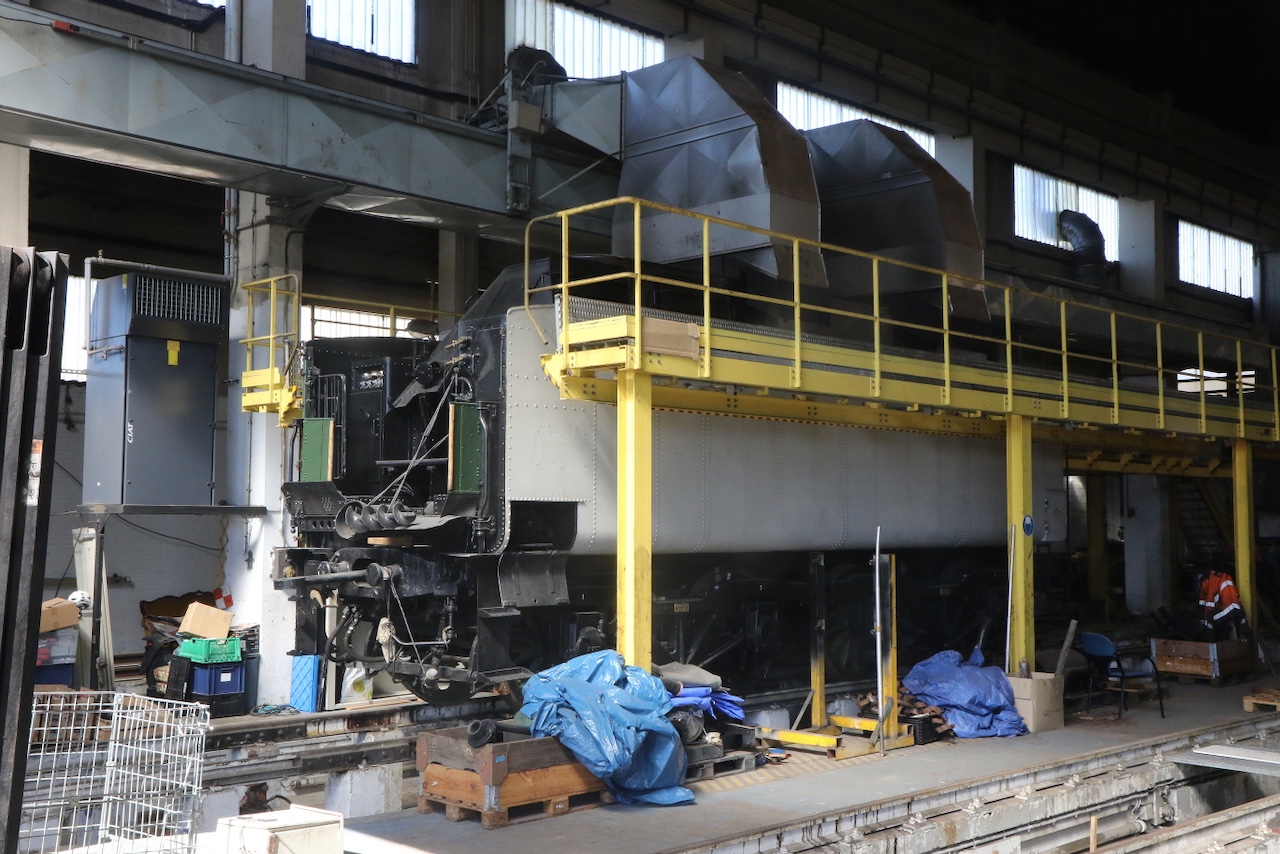


140 C 27 is seen above on 20th April with Le Thermal Express tour passing through La Bourboule where it halted shortly afterwards at the water terminal loop. It then ran a shuttle to and from Laqueuille before returning to Clermont-Ferrand. X 2403 was also operating that day, seen between the carrées at Volvic. Both photos: Erwan Quintin.
The new group hopes to counter the lack of interest on the part of Nouvelle-Aquitaine and AURA régions in a reopening that would serve a widely-scattered population and stimulate tourism in some of the most isolated parts of the country. A large proportion of the area’s tourist accommodation is concentrated around the popular thermal resorts of La Bourboule and Le Mont-Dore, currently some 90min by bus from Clermont. The proposal would involve restoring the entire route traversed by the two railtours as well as Laqueuille – Ussel, a total of 97km. The line remains in service between Volvic and La Bourboule for trains carrying mineral water, while the last 5km to the terminus at Le Mont-Dore has been severed.
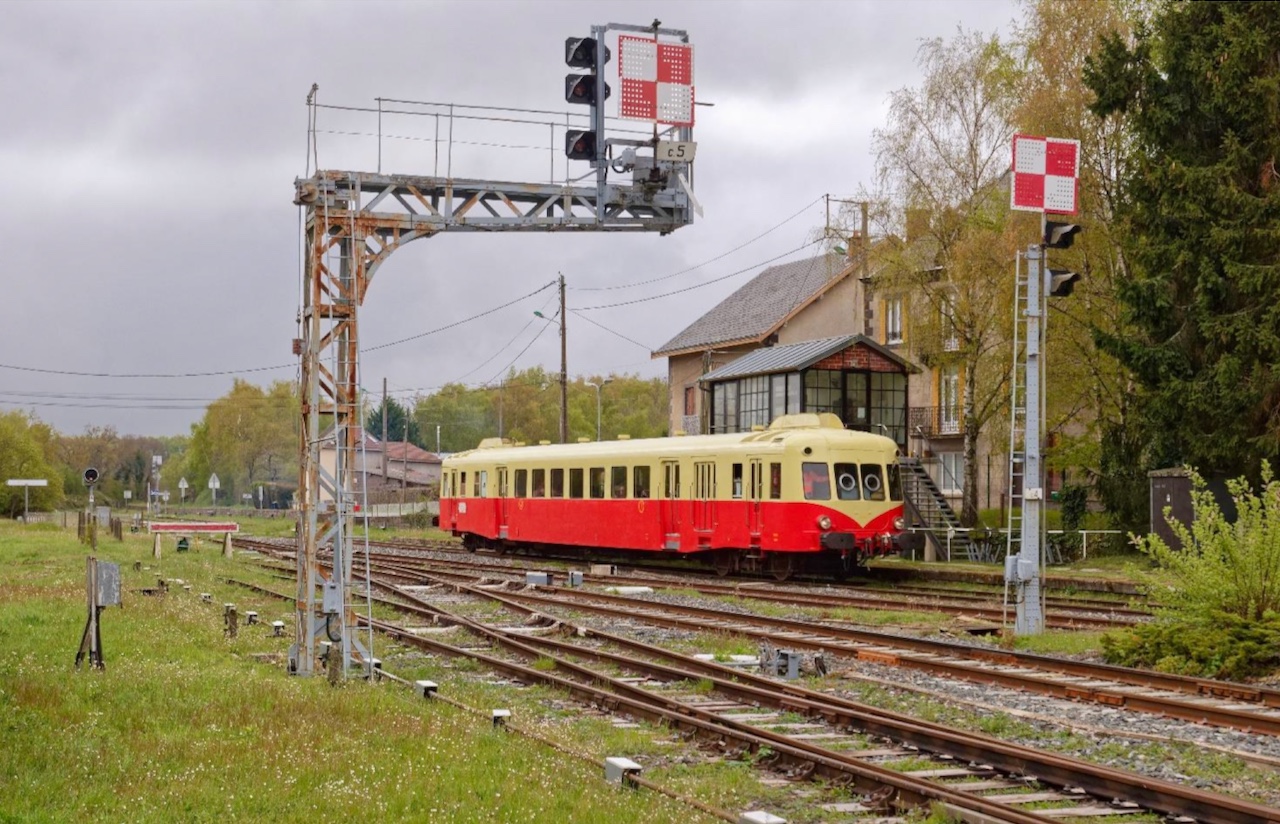
Below. On the 21st April CFTLP (Conservatoire Ferroviaire Territoires Limousin Périgord) ran a pre-season mixed running-in train from Limoges to Nexon topped and tailed by 141 TD 740 and 040 DE 895 (BB 63895). In a scene reminiscent of the late 1950s 040 DE 895 is seen approaching Nexon on the outward journey. Photo: Erwan Quintin.
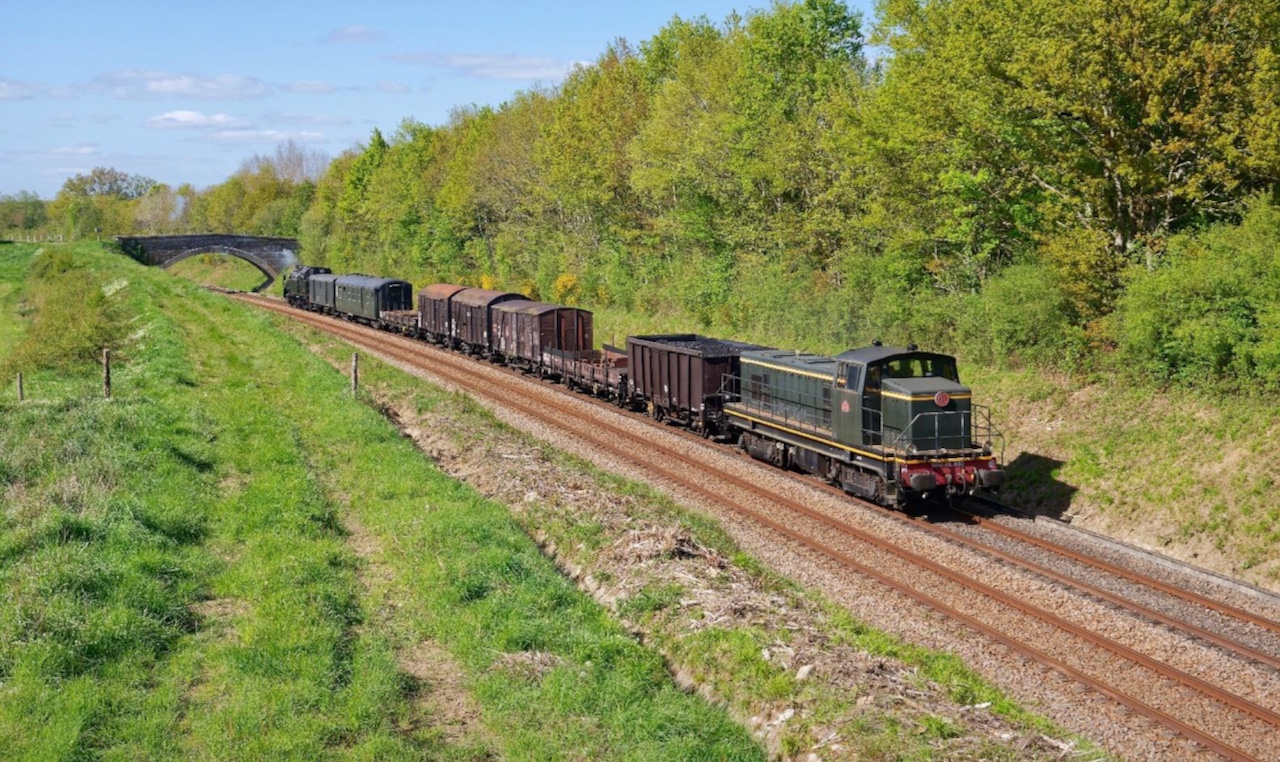
Urban Rail
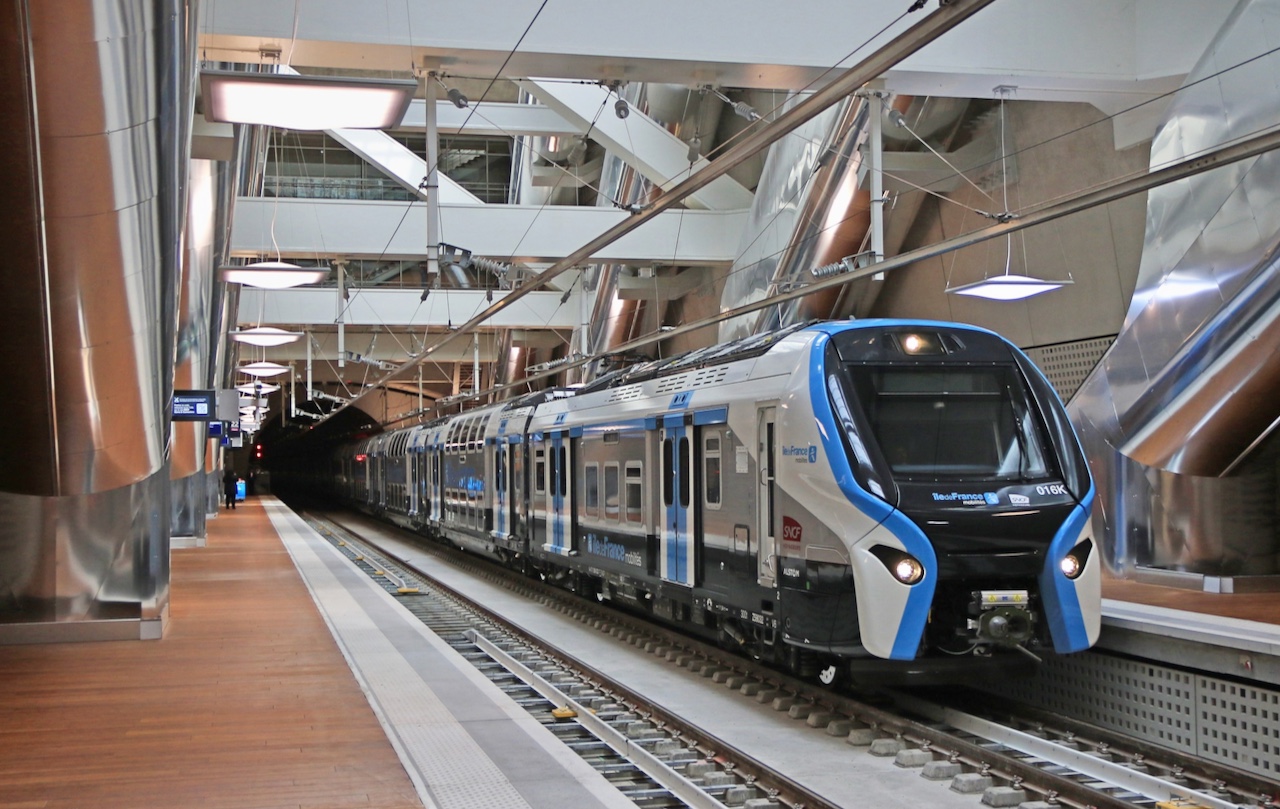
RER E extension to Nanterre-La Folie opens
The 8km western extension of RER Line E from Haussmann-Saint Lazare to Nanterre-La Folie opened on 6th May (see May News). The first public working from Nanterre is seen above in the new underground station at Neuilly-Porte Maillot comprised of NG units 016K/018K. For the moment, a shuttle service runs every 15 minutes between Magenta-Gare du Nord and Nanterre from 10.00 to 16.00 (20.00 at weekends) until sufficient NG trains become available to operate the full timetable. Until then, passengers must change at Magenta to continue their journeys eastwards. Late deliveries from Alstom mean that only 14 sets are currently available, but the service will be augmented during the Olympic Games period and 34 trains should be in operation by the end of the year.
Earlier, on 3rd May, an official opening ceremony was held at La Défense-Grande Arche (right), with Prime Minster Gabriel Attal, SNCF’s Jean-Pierre Farandou and ÎdeF Mobilitiés president Valérie Pécresse in attendance. A new island platform station extending over 18,000m2 has been built here beneath the Centre des Nouvelles Industries et Technologies. Due to covid and other factors, the Éole project is running more than two years late and the budget of €3.7 billion has increased to €5.4 billion. The additional cost has been funded by the communes of Île-de-France and the région.
Photos: Christophe Masse and Île-de-France Mobilités.
Photos: Christophe Masse and Île-de-France Mobilités.
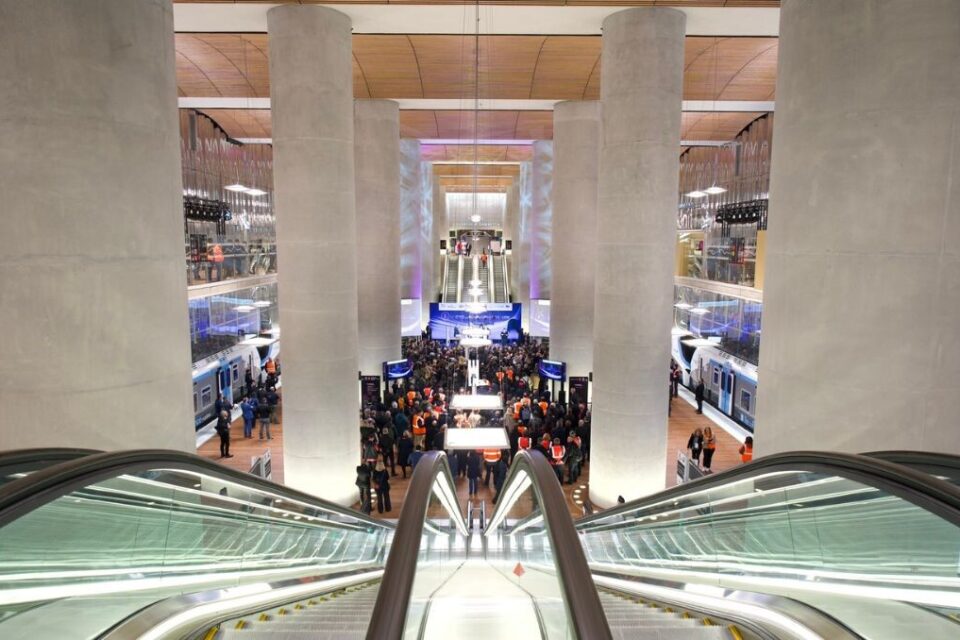
RER Line A. The new control centre at Vincennes, bringing together staff of the line’s joint operators, SNCF and RATP, was officially opened on 25th April. Amongst the many benefits are improved communication with drivers, station staff and maintenance teams, and new train control and incident management tools. Crew-change at Nanterre-Préfecture, often a source of delay, has been eliminated.
Photo: Île-de-France Mobilités/Hamdi Chref.

Video surveillance. SNCF and RATP have been authorised to use algorithmic video surveillance during the Olympic Games after a trial over the weekend of 19th/22nd April. Cameras can detect intrusion and unusual crowd movement in high-risk areas, abnormally high density, and presence of abandoned luggage. They will not be equipped for facial recognition.

Nantes. The first two of Naolib’s new fourth-generation Citadis trams entered public service on Line 1 on 15th April, followed by an official ‘first day’ of special events on 18th May attended by large crowds. The 61 cars being built by Alstom will be delivered progressively through to 2026. Photo: Ouest-France.
Lyon T9. Preliminary work began at Charpennes in February prior to start of full-scale construction on 8th May. T9 will utilise the existing T3/4 alignment from Charpennes (metro Lines A/B interchange) to Croix-Luizet then run over 8.8km of new track through Villeurbanne to La Soie in Vaulx-en-Velin with 12 stops. At La Soie there will be a further Line A connection as well as interchange with T3/7 and Rhônexpress to Saint Exupéry airport. Opening is scheduled for 2026.
Lille. Four metro stations are being renamed: Caulier becomes Madeleine Caulier, Alsace becomes Alsace Plaine Images, Cantelu becomes Cantelu Euratechnologies, and Porte de Douai will be Jardin des Plantes.
Rennes Line B. In an update published on 13th May, Rennes Métropole said that trains were being repaired at a rate of three per week and it was cautiously optimistic that 18 sets would be passed for service by mid-June, sufficient to resume operation of Line B. Following the incident on 3rd January (see February News), the centre-pivots of all 100 bogies are being replaced.
Sixty years on. RATP’s last MP59 train was withdrawn from Line 11 on 23rd May. Having entered service in 1963 on Line 1 and then Line 4, these were the oldest Paris metro trains and amongst the oldest stock in regular use in Europe.
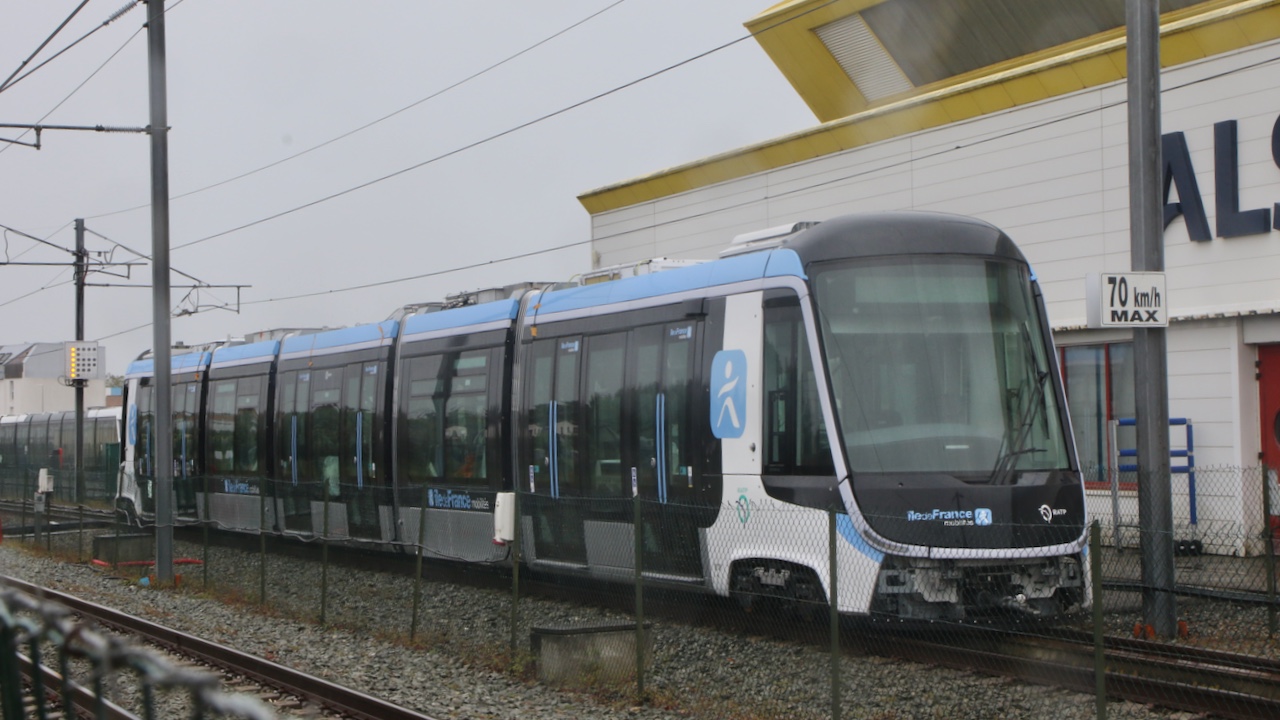
Paris T1. The first of 37 Citadis X05 trams being built for tram route T1 has been rolled out at Alstom’s La Rochelle plant. Costing €130 million and branded as TW20 by RATP they are expected to enter service later this year, replacing the 30-year old TFS trams
Opened in 1992 line T1 has been undergoing a €60 million upgrade to renovate platforms and shelters and renew track. T1 is being extended from Noisy-le-Sec to Val-de-Fontenay that should open in two stages in 2026 and 2028. In the west, branches from Asnières to Colombes and Rueil are planned to open by 2028-29.
Photo: Georges Turpin.
Train des Mouettes celebrated its 40th anniversary on 1st April when Schneider 42 030 T3 ‘Progrès’ was steamed for the first time after major overhaul. Built in 1891, this is France’s oldest standard-gauge steam locomotive passed for running. The 21km line between Saujon and La Tremblade, owned by Charente-Maritime département and operated by l’Association Trains & Traction, carried a record 47,000 passengers in 2023 and is hoping to attract 55,000 during its anniversary season starting on 25th April.
February saw the first work in a six-year programme of relaying and reballasting, financed by the département to the tune of €10 million. Initially, 400m of the oldest track has been replaced at Saujon; further work over next winter will extend the line by 260m to the harbour and Capitainerie at La Tremblade, at a cost of €1.7 million. The Capitainerie extension has been put off for at least a year as the département is short of money.
Photo: Le Parisien/Fabien Paillot.
Photo. Georges Turpin

